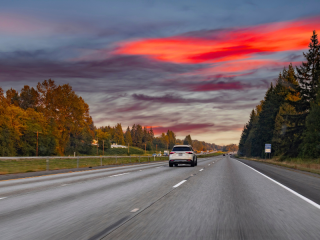
There have been 8 significant changes made to the Highway Code in 2022, including the restructuring of the ‘hierarchy of road users’ which has provided clarity over who has right of way at junctions.
These changes are designed to improve road safety for people walking, cycling, and riding horses, so it’s important that drivers are aware of the new regulations and follow them accordingly.
To help you understand the recent Highway Code changes, we have collated all the key information you need to know. We’ve also highlighted the responsibilities that drivers need to undertake to ensure that they remain safe on the road and protect other vulnerable road users.
1. New ‘hierarchy of road users’
The Highway Code was updated on 29th January to include rules on the new ‘hierarchy of road users’. This is one of the most significant changes to the Highway Code as it clearly defines the road users that are most at risk if a collision occurs and highlights who should be prioritised on the roads.
Drivers of vehicles at the bottom of the hierarchy are considered more capable of causing harm in the event of a collision and have the greatest responsibility to reduce the danger to others.
The new ‘hierarchy of road users’ is:
Pedestrians
Cyclists
Horse riders
Motorcyclists
Cars/taxis
Vans/minibuses
Large passenger vehicles/HGVs
These changes give priority to pedestrians and cyclists, however, all road users have a responsibility to ensure their own safety and protect others, so need to be vigilant whilst on the road.
2. Pedestrians crossing the road at junctions
The updated Highway Code has new rules that are in place to improve the safety of pedestrians. It now clarifies that:
Traffic should give way when pedestrians are crossing, or waiting to cross, at a junction.
If pedestrians have started crossing and traffic wants to turn into the road, then the traffic should give way. This is because the people crossing have priority.
People driving, riding a motorcycle, or cycling must give way to pedestrians on a zebra crossing and those walking or cycling on a parallel crossing. (Similar to a zebra crossing but includes a cycle route alongside the black and white stripes)
3. Walking, cycling, or riding in shared spaces
There are some routes and spaces that are shared by people walking, cycling, and riding horses, so it’s extremely important that you’re always aware of your surroundings to ensure that these areas remain safe for everyone. The Highway Code dictates that pedestrians should avoid obstructing or endangering cyclists and horse riders whenever they’re walking in shared spaces. However, for cyclists, there are more specific regulations which include:
Not passing pedestrians walking, riding a horse, or driving a horse-drawn vehicle closely or at a high speed, particularly if travelling towards them from behind.
Slowing down or stopping when necessary and letting pedestrians walking know they are there, for example by ringing their bell.
Remembering that pedestrians walking may be deaf, blind, or partially sighted so extra care should be taken.
Not passing a horse on the horse’s left and be sure to leave plenty of room when overtaking.
4. Positioning on the road when cycling
There is new guidance in the Highway Code about where cyclists should position themselves on the road which includes:
Riding in the centre of the lane on quiet roads, in slower-moving traffic and at the approach to junctions or sections where the road becomes narrow. This allows cyclists to be as visible as possible to other road users.
Keeping at least 0.5 metres (just over 1.5 feet) away from the kerb edge when riding on busy roads with vehicles moving faster than them. Cyclists should keep further away from the kerb edge than this if it’s safe to do so.
5. Overtaking when driving or cycling
The regulations on safe passing distances and speeds for those overtaking vulnerable road users have been updated in the recent Highway Code changes. Drivers now need to:
Leave at least 1.5 metres (5 feet) when overtaking cyclists at speeds of up to 30mph and give even more space when overtaking at higher speeds.
Overtake horse-riders and those driving horse-drawn vehicles at less than 10mph and give at least 2 meters (6.5 feet) of space.
Allow a minimum of 2 metres (6.5 feet) of space and keep to a low speed when passing people walking on the road, such as when there’s no pavement.
If it’s not possible to meet these requirements, then drivers should be prepared to slow down and wait behind the other road user until it’s safe to overtake.
The updated Highway Code also clarifies that cyclists can pass slower-moving or stationary traffic on their right or left. However, this should always be done cautiously as they may not be seen as easily by drivers. Long vehicles, in particular, have blind spots which can be dangerous for cyclists.
The general rule of thumb is that if you can’t see the vehicle’s wing mirrors then the driver won’t be able to see you and so you should avoid overtaking.
6. People cycling at junctions
The Highway Code has been adapted to provide clarification on how cyclists can act safely at junctions. The guidance now highlights that when turning into or out of a side road, cyclists should give way to pedestrians who are crossing or waiting to cross.
In addition, the code clarifies that cyclists who are going straight ahead at a junction have priority over traffic waiting to turn into or out of a side road unless road signs or markings indicate otherwise.
7. People cycling, riding a horse, and driving horse-drawn vehicles on roundabouts
To help ensure the safety of vulnerable road users on roundabouts, the Highway Code has been changed to give priority to cyclists on roundabouts. The new guidance highlights that people driving or riding a motorcycle should:
Not attempt to overtake cyclists which are in your lane.
Allow cyclists to move across their path as they travel around the roundabout.
Additional guidance has also been included to clarify that drivers should ensure they do not cut across cyclists, horse-riders, or those driving a horse-drawn vehicle who are continuing around the roundabout in the left-hand lane.
8. Parking, charging and leaving vehicles
The ‘waiting and parking’ section of the Highway Code has been updated to include a new technique for exiting vehicles called the ‘Dutch Reach’. This method involves you opening your vehicle door with the hand on the opposite side of the door you’re opening. For example, using your left hand to open a door on your right-hand side. The purpose of this technique is to encourage drivers to turn their heads and look over their shoulders to check for hazards before opening their doors.
The UK Government is actively encouraging the use of electric vehicles and so there have been significant investments into the EV charging point infrastructure. The Highway Code has therefore been adapted to include guidelines around how to safely use EV charging points. It’s advised that when drivers are using these charge points, they should:
Park close to the charge point and avoid creating a trip hazard from trailing cables.
Display a warning sign, if possible.
Return charging cables and connectors to the correct location, minimising the risk to others and preventing an obstacle for other road users.
Responsibility for fleets
It's essential that drivers familiarise themselves with the new Highway Code changes so that they can remain safe and lawful on the road.
Businesses are responsible for ensuring that their drivers are aware of these changes and understand how they will affect the way they drive. This is important as it will not only help to prevent collisions but can save your business from financial penalties and prosecution which can occur if drivers fail to understand and follow the new changes.
Our range of fuel cards can help businesses monitor their drivers’ behaviour to ensure that they’re acting responsibly. You’ll also be able to easily track your fuel expenditure online which can help to save you time and money. If you’re interested in finding out more, then call our expert team at 0113 202 5110, so we can determine which fuel card is right for your needs.




